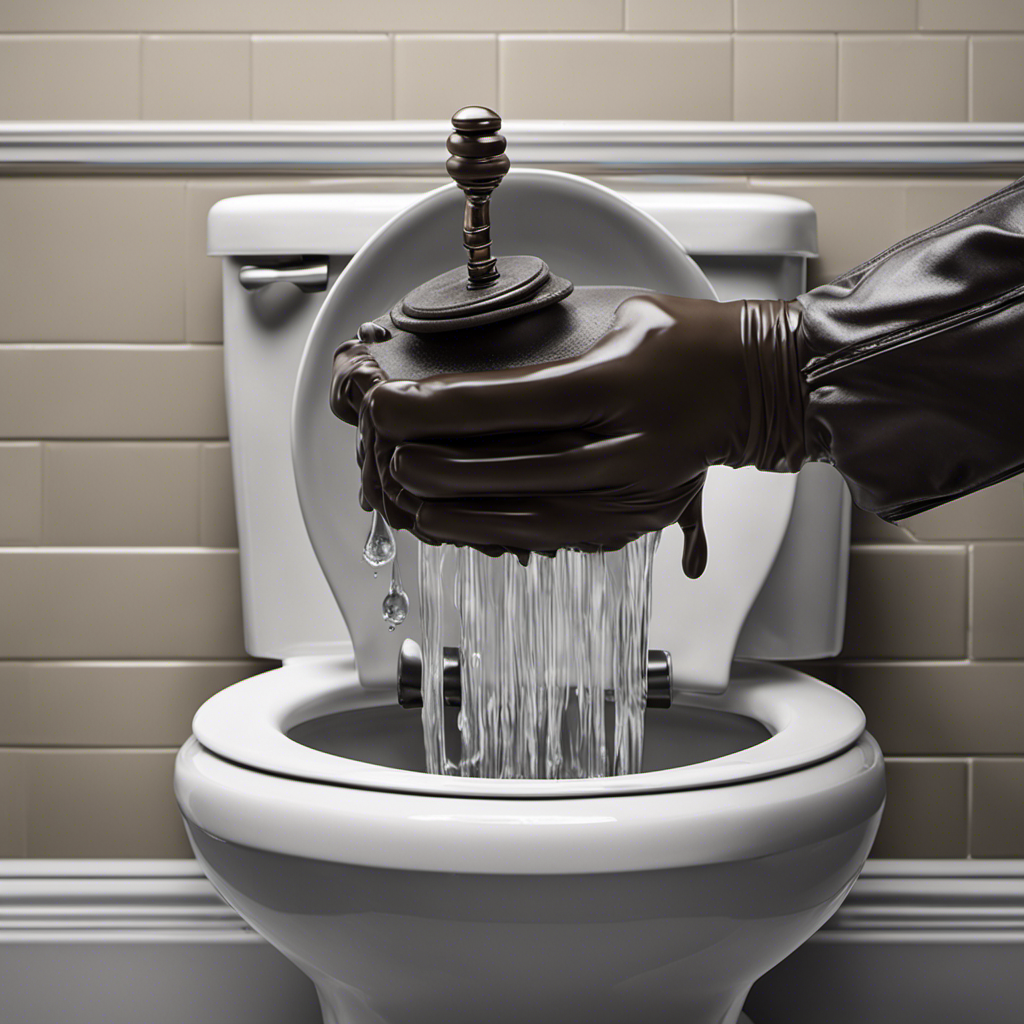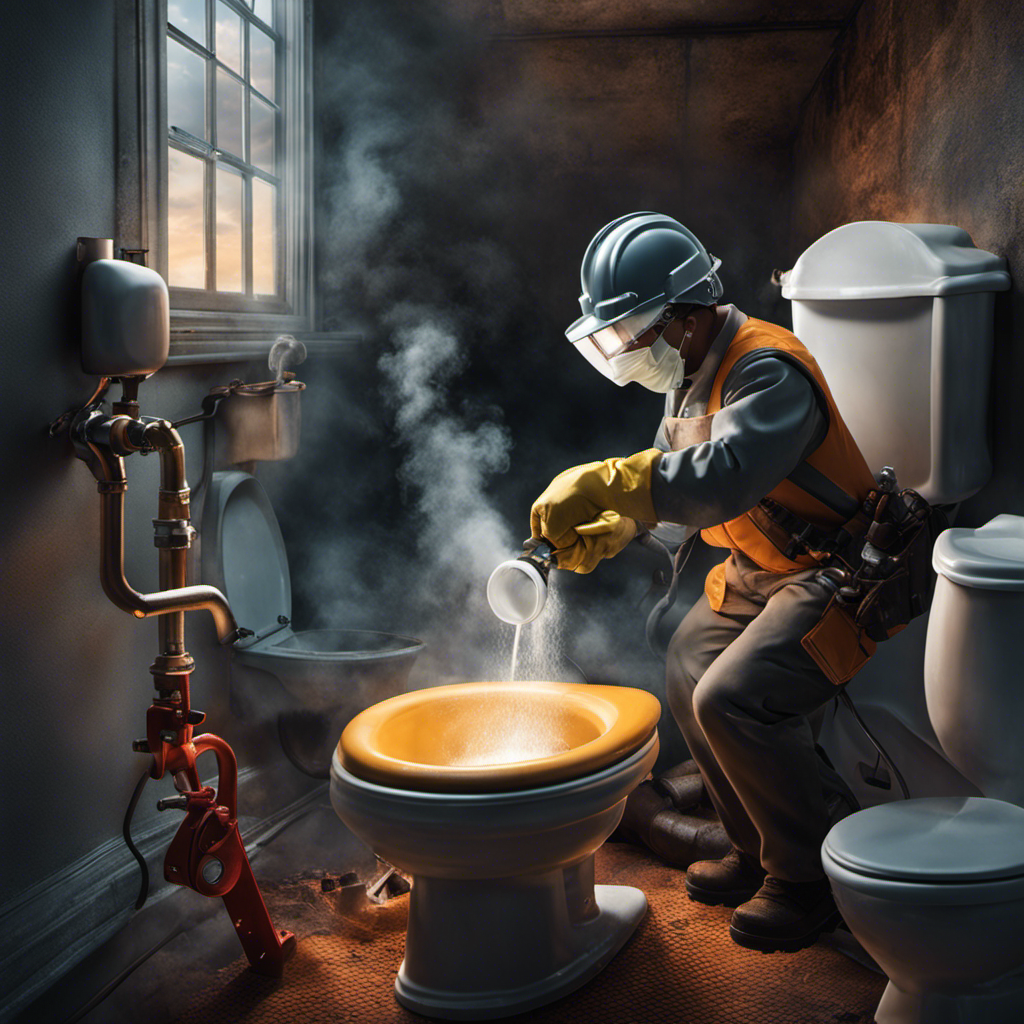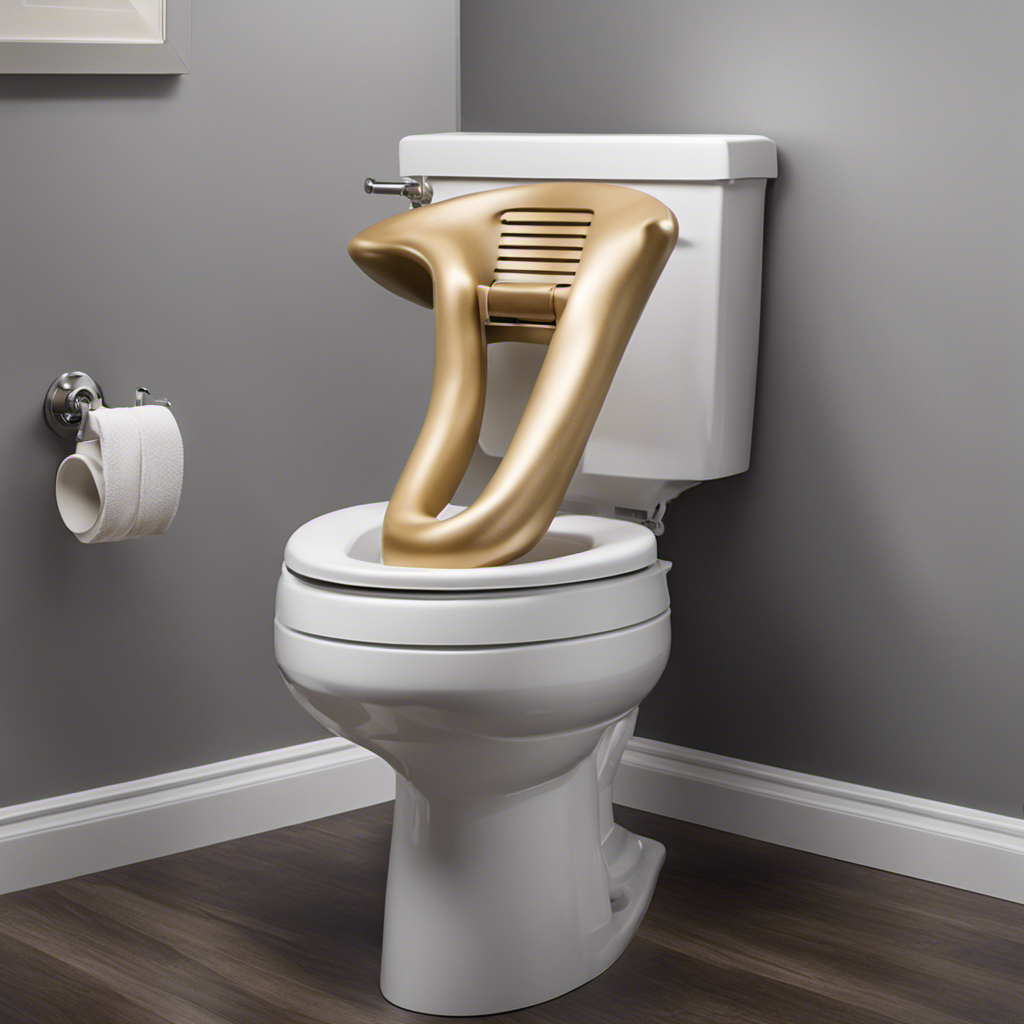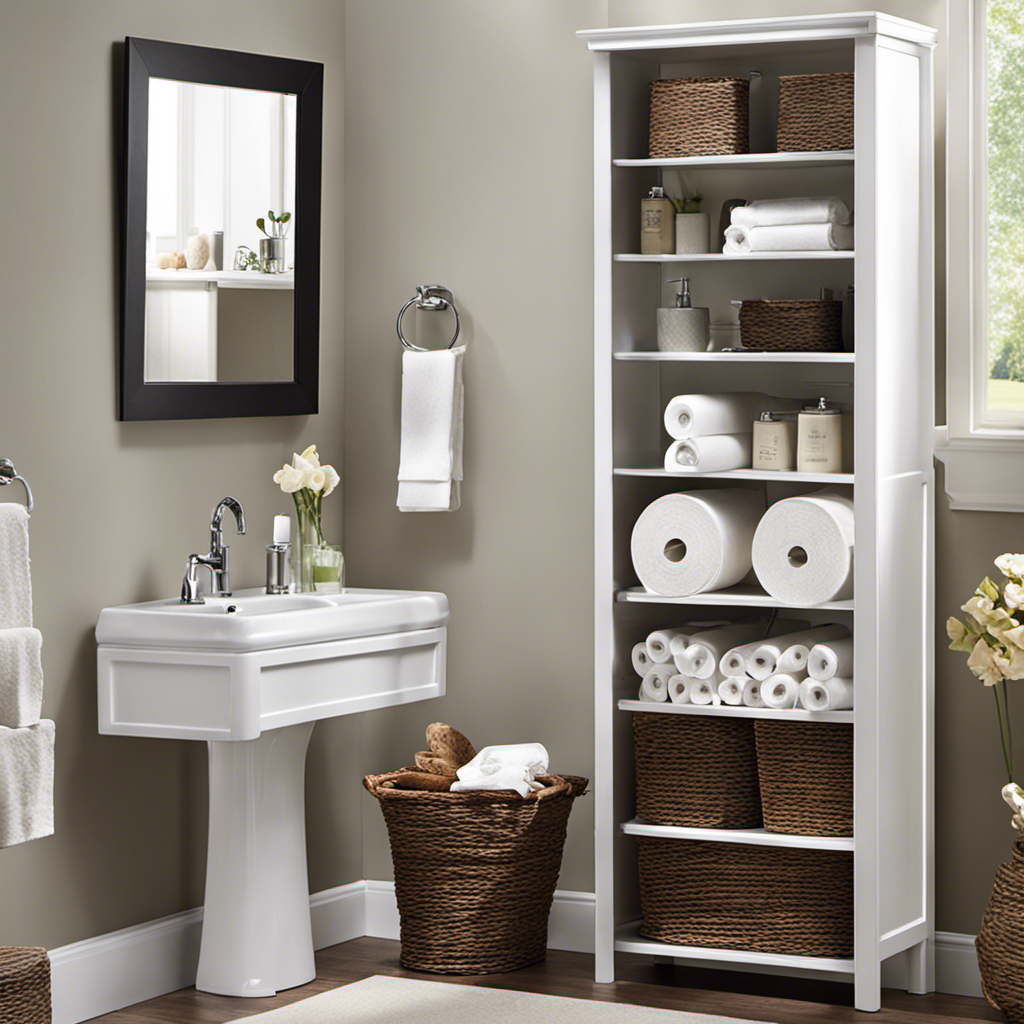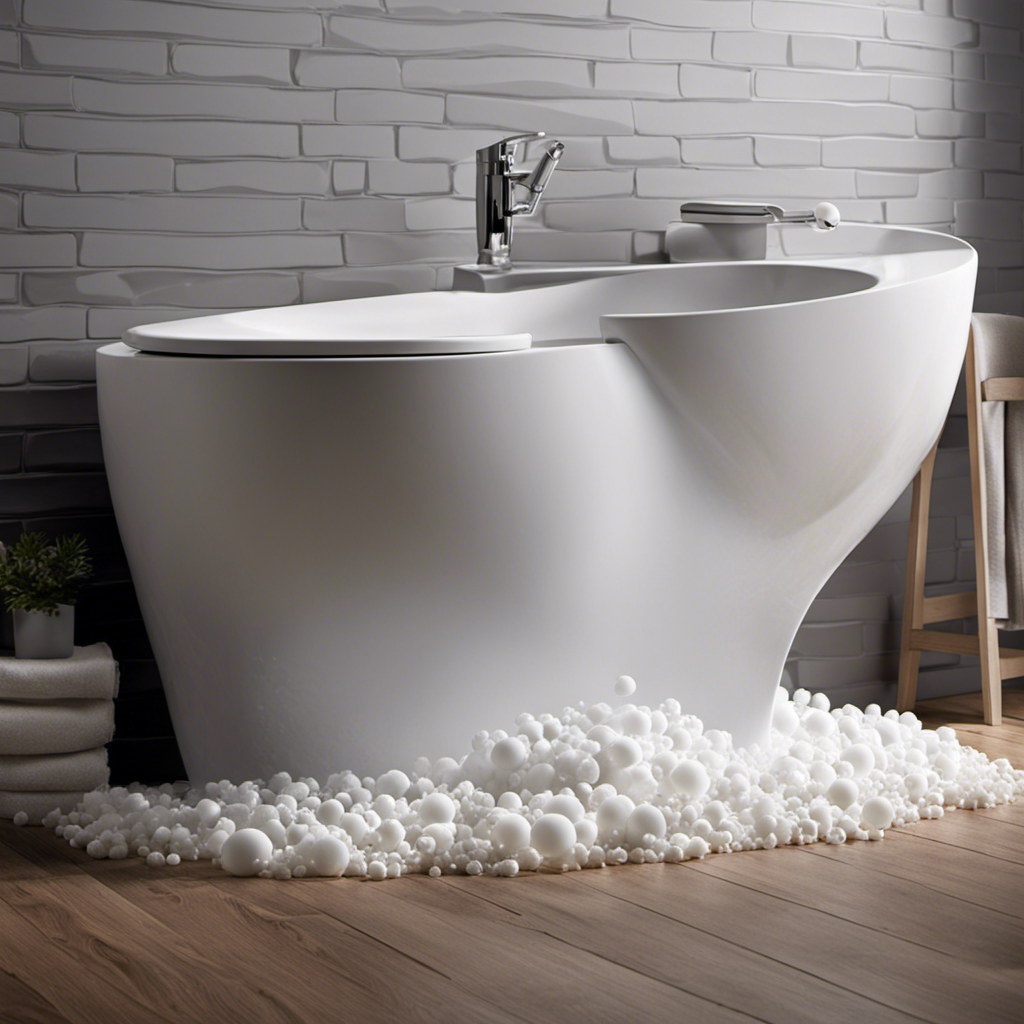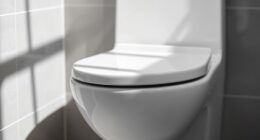Hey there!
Ever had the unfortunate experience of an overflowing toilet? Trust me, I’ve been there too. But fear not, because I’ve got you covered with a step-by-step guide on how to fix this messy situation.
From understanding the causes to shutting off the water supply, using a plunger or plumbing snake, and even fixing faulty valves, we’ll cover it all.
So, let’s roll up our sleeves and get ready to tackle this problem head-on!
Key Takeaways
- The causes of an overflowing toilet can include blockages in the drain pipe and a malfunctioning flapper valve.
- It is important to shut off the water supply and remove excess water from the floor to prevent further damage.
- Safety precautions such as wearing gloves and protective clothing should be taken when dealing with an overflowing toilet.
- Methods for clearing toilet blockages include using a plunger, toilet auger, dish soap and hot water, wire hanger, or chemical drain cleaners.
Understanding the Causes of an Overflowing Toilet
Understanding the causes of an overflowing toilet can help you prevent future incidents.
When it comes to the causes of toilet overflow, the most common culprit is a blockage in the drain pipe. This can occur due to a buildup of toilet paper, sanitary products, or even foreign objects that have been accidentally flushed.
Another cause can be a malfunctioning flapper valve, which fails to seal properly and allows water to continuously flow into the toilet bowl.
Signs of a toilet blockage include slow drainage, gurgling sounds, or water rising to the brim of the bowl.
Assessing the Severity of the Overflow
To determine how severe the situation is, you can start by checking the water level in the bowl and assessing the amount of water on the floor. This will give you an idea of the extent of the overflow and help you gauge the severity of the situation.
Here are some things to consider during your severity assessment:
-
Water level in the bowl: Is the water close to or overflowing from the rim? This indicates a more severe overflow.
-
Amount of water on the floor: Is there just a small puddle or is the entire bathroom flooded? The more water on the floor, the more damage it can cause.
-
Duration of the overflow: Has the toilet been overflowing for a long time? Prolonged overflow can lead to water damage to the floors and walls.
-
Contamination: Is the overflow water clean or does it contain waste? Contaminated water poses health risks and requires immediate attention.
Shutting Off the Water Supply to the Toilet
When faced with an overflowing toilet, it’s crucial to take immediate action to prevent further damage.
The first step is to turn off the water supply to the toilet. Locate the shut-off valve, usually located behind or beside the toilet, and turn it clockwise to shut off the water flow. This will help stop the toilet from overflowing and minimize any potential water damage.
Additionally, it’s important to take safety precautions, such as wearing gloves and protective clothing, to avoid any contact with contaminated water.
Turning off Water
First, you’ll want to locate the shut-off valve to stop the water flow. This is typically located behind the toilet, near the floor. Once you’ve found it, follow these steps to turn off the water:
-
Turn the valve clockwise: As you slowly turn the valve, you’ll feel some resistance. Keep turning until it is fully closed. This will stop the water from flowing into the toilet.
-
Check the water pressure: After turning off the water, flush the toilet to release any remaining water in the tank. Then, turn on a faucet in another part of the house to see if there is any water pressure. If there is, it means the shut-off valve is not fully closed and you may need to tighten it further.
-
Listen for any sounds: If you can still hear water running or hissing sounds after turning off the water, it may indicate a larger issue with the plumbing system. In this case, it’s best to call a professional plumber for further assistance.
-
Double-check the valve: Before moving on to the next step, make sure the shut-off valve is completely closed and there is no water flow.
Preventing Further Damage
By following these steps, you can successfully stop any further damage from occurring.
After turning off the water supply to your overflowing toilet, it’s essential to take immediate action to prevent any additional damage.
First, grab a bucket or a mop and start removing the excess water from the floor. This will help prevent water from seeping into your walls or causing structural damage.
Next, assess the situation and determine if there are any visible signs of damage, such as cracks or leaks. If you notice any, it’s crucial to address them right away to prevent further issues.
For emergency repairs, consider using a sealant or waterproof tape to temporarily fix the problem until a professional plumber can assess and rectify the situation.
Safety Precautions
Now that we’ve discussed how to prevent further damage when dealing with an overflowing toilet, let’s talk about the safety measures you should take during the process.
It’s important to prioritize your well-being and protect yourself from any potential harm. Here are some key safety precautions to keep in mind:
-
Wear protective gear: Put on rubber gloves and safety goggles to shield yourself from any bacteria or harmful chemicals that may be present.
-
Turn off the water supply: Locate the shut-off valve behind the toilet and turn it clockwise to stop the flow of water.
-
Use proper ventilation: Open windows or turn on fans to ensure good air circulation and prevent the buildup of harmful fumes.
-
Avoid mixing chemicals: Never mix different cleaning products as it can create toxic fumes. Stick to one type of cleaner at a time.
Clearing the Clog Using a Plunger
To clear the clog using a plunger, you’ll need to make sure there’s enough water in the toilet bowl. This helps create a good seal between the plunger and the drain. If there isn’t enough water, you can add some manually until it covers the rubber cup of the plunger. Once you’re ready, firmly place the plunger over the drain hole and push down gently. Then, quickly pull up to create suction and release it. Repeat this plunging motion several times until the water starts to drain. If the plunger doesn’t work or you don’t have one, there are alternatives you can try to unclog the toilet without chemicals. Here’s a comparison table to help you choose the best method for your situation:
| Method | Advantages | Disadvantages |
|---|---|---|
| Plunger | Easy to use | May not work for severe clogs |
| Toilet auger | Effective for tough clogs | Can scratch porcelain surfaces |
| Dish soap and hot water | Breaks down clogs naturally | Requires time and multiple attempts |
| Wire hanger | Inexpensive and easily accessible | Can damage the toilet if not used properly |
Choose the method that suits your needs and give it a try. Remember to always follow the instructions carefully to avoid further damage to your toilet.
Using a Plumbing Snake to Remove Stubborn Blockages
When it comes to using a plumbing snake to remove stubborn blockages, it’s important to consider the effectiveness of the technique.
The snake is highly effective in breaking up and removing blockages caused by solid materials such as hair, grease, and soap scum.
However, it may not be as effective in dealing with blockages caused by tree roots or other solid objects. Therefore, it’s essential to identify the type of blockage before attempting to use a snake.
Additionally, safety precautions should always be taken when snaking, such as wearing gloves and protective eyewear to prevent any injuries from occurring.
Snake Technique Effectiveness
If you’ve tried using a plunger and the toilet is still overflowing, you might want to consider using the snake technique to clear the blockage. Here are some alternatives to using a snake and the pros and cons of using this method:
-
Chemical Drain Cleaners: These can be effective in breaking down clogs, but they can also damage pipes and be harmful to the environment.
-
Hot Water and Dish Soap: This method can help dissolve grease and loosen up minor clogs, but it may not be effective for more stubborn blockages.
-
Enzyme-Based Cleaners: These cleaners use natural enzymes to break down organic matter, making them safe for pipes and the environment. However, they may take longer to work.
-
Plumbing Auger: Similar to a snake, a plumbing auger is a flexible rod with a corkscrew-like end. It can be effective in removing tough clogs, but it requires more skill to use properly.
Ultimately, the snake technique can be a reliable and efficient way to clear stubborn blockages, but it’s important to weigh the pros and cons and choose the method that suits your situation best.
Common Blockage Types
After discussing the effectiveness of the snake technique, let’s move on to the different types of blockages you may encounter when dealing with an overflowing toilet. Understanding the cause of the blockage can help you choose the most appropriate method to fix the problem.
| Blockage Type | Description |
|---|---|
| Organic | Caused by waste materials such as toilet paper. |
| Foreign Object | Occurs when an object gets stuck in the toilet. |
| Grease | Result of pouring cooking oil or grease down the toilet. |
To clear a blockage caused by organic waste or a foreign object, a plunger can be an effective tool. There are two main types of plungers: the cup plunger and the flange plunger. The cup plunger is suitable for sinks and tubs, while the flange plunger is designed specifically for toilets.
If the blockage is caused by grease, you can try using DIY drain cleaning methods such as pouring boiling water or a mixture of vinegar and baking soda down the toilet.
Now that we’ve covered the different types of blockages, let’s move on to discussing the safety precautions when snaking.
Safety Precautions When Snaking
To ensure your safety while snaking, remember to wear protective gloves and eyewear to prevent any potential injuries. Cleaning out a clogged toilet with a snake can be a messy and potentially dangerous task, so it’s important to take the necessary precautions. Here are four reasons why wearing protective gear is crucial:
-
Shield against harmful bacteria: The snake comes into contact with waste and bacteria, which can easily transfer to your hands and eyes if not protected.
-
Prevent injuries from sharp objects: A snake can encounter sharp objects or debris within the pipes, and wearing gloves will protect your hands from cuts or punctures.
-
Avoid chemical exposure: In some cases, chemicals may be used in combination with the snake to break down blockages. Protective eyewear will shield your eyes from any splashes or spills.
-
Maintain personal hygiene: Wearing gloves and eyewear will help you maintain cleanliness and prevent the spread of germs during the snaking process.
Now that you understand the importance of protective gear, let’s move on to fixing a faulty fill valve.
Fixing a Faulty Fill Valve
First, check if the fill valve is faulty by listening for any unusual sounds or observing water continuously running into the toilet bowl. If you hear a hissing or gurgling noise, or if the water level is too high or too low, there may be a problem with the fill valve.
To fix a fill valve leak, start by turning off the water supply to the toilet. Then, flush the toilet to drain the tank. Next, remove the refill tube and unscrew the lock nut holding the fill valve in place. Replace the faulty fill valve with a new one, making sure it is securely tightened.
Preventing Future Toilet Overflows With Regular Maintenance
Maintaining your toilet regularly can help you prevent future incidents of water overflowing and causing damage. Here are four reasons why regular maintenance is essential:
-
Avoid costly repairs: By inspecting and maintaining your toilet regularly, you can catch small issues before they become major problems. This can save you money on expensive repairs down the line.
-
Extend the lifespan of your toilet: Regular maintenance, such as cleaning and checking for leaks, can help prolong the life of your toilet. This means you won’t have to replace it as frequently, saving you both money and the hassle of a bathroom renovation.
-
Ensure proper water pressure: Adequate water pressure is crucial for proper flushing and preventing clogs. Regular maintenance includes checking the water pressure and adjusting it if necessary to ensure optimal performance.
-
Preserve your home’s integrity: Water overflowing from a toilet can cause significant damage to your floors, walls, and ceilings. By taking the time to maintain your toilet, you can prevent these incidents and protect the integrity of your home.
Frequently Asked Questions
How Much Does It Cost to Fix an Overflowing Toilet?
Fixing an overflowing toilet can be costly, especially if you need to hire a professional plumber. The cost estimation will depend on the extent of the damage and the expertise required for the repair.
Can I Use Chemical Drain Cleaners to Clear a Clog in My Toilet?
Using chemical drain cleaners to clear a toilet clog is not recommended. They can damage pipes and may not be effective. It’s best to try alternative methods like using a plunger or a toilet auger.
What Should I Do if the Water Supply Valve to the Toilet Is Stuck?
If the water supply valve to the toilet is stuck, don’t panic. First, try gently turning the valve clockwise to loosen it. If that doesn’t work, there are alternative solutions to shut off the water.
Are There Any Special Precautions I Should Take When Using a Plumbing Snake?
Before using a plumbing snake, it’s crucial to take certain precautions. Make sure to wear gloves and eye protection. Carefully feed the snake into the drain, rotating it as you go.
How Often Should I Schedule Regular Maintenance to Prevent Future Toilet Overflows?
Regular toilet maintenance is crucial to prevent future overflows. I recommend scheduling maintenance every six months or so. Common causes of overflows include clogs, faulty fill valves, and worn-out flappers. Stay proactive to avoid messy situations!
Conclusion
In conclusion, fixing an overflowing toilet may seem like a messy and daunting task, but it can be a simple and practical solution with the right knowledge and tools.
By understanding the causes, assessing the severity, and taking necessary steps like shutting off the water supply, using a plunger or plumbing snake, and fixing a faulty fill valve, you can tackle the problem head-on.
With regular maintenance, you can prevent future toilet overflows and ensure a smoothly running bathroom.
So don’t let the fear of an overflowing toilet hold you back. Roll up your sleeves and get to work!
